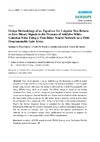Identificador persistente para citar o vincular este elemento:
https://accedacris.ulpgc.es/jspui/handle/10553/44000
| Campo DC | Valor | idioma |
|---|---|---|
| dc.contributor.author | Pérez Suárez, Santiago T. | en_US |
| dc.contributor.author | Travieso González, Carlos M. | en_US |
| dc.contributor.author | Alonso Hernández, Jesús B. | en_US |
| dc.date.accessioned | 2018-11-21T19:28:30Z | - |
| dc.date.available | 2018-11-21T19:28:30Z | - |
| dc.date.issued | 2013 | en_US |
| dc.identifier.issn | 1424-8220 | en_US |
| dc.identifier.uri | https://accedacris.ulpgc.es/handle/10553/44000 | - |
| dc.description.abstract | This article presents a design methodology for designing an artificial neural network as an equalizer for a binary signal. Firstly, the system is modelled in floating point format using Matlab. Afterward, the design is described for a Field Programmable Gate Array (FPGA) using fixed point format. The FPGA design is based on the System Generator from Xilinx, which is a design tool over Simulink of Matlab. System Generator allows one to design in a fast and flexible way. It uses low level details of the circuits and the functionality of the system can be fully tested. System Generator can be used to check the architecture and to analyse the effect of the number of bits on the system performance. Finally the System Generator design is compiled for the Xilinx Integrated System Environment (ISE) and the system is described using a hardware description language. In ISE the circuits are managed with high level details and physical performances are obtained. In the Conclusions section, some modifications are proposed to improve the methodology and to ensure portability across FPGA manufacturers | en_US |
| dc.language | spa | en_US |
| dc.publisher | 1424-8220 | - |
| dc.relation.ispartof | Sensors | en_US |
| dc.source | Sensors (Switzerland)[ISSN 1424-8220],v. 13, p. 16829-16850 | en_US |
| dc.subject | 3307 Tecnología electrónica | en_US |
| dc.subject.other | equalizer; AWGN; neural network; FPGA; floating point; fixed point; Matlab; Simulink; System Generator; ISE | en_US |
| dc.title | Design methodology of an equalizer for unipolar non return to zero binary signals in the presence of additive white Gaussian Noise using a time delay neural network on a field programmable gate array | en_US |
| dc.type | info:eu-repo/semantics/Article | es |
| dc.type | Article | es |
| dc.identifier.doi | 10.3390/s131216829 | |
| dc.identifier.scopus | 84889843316 | - |
| dc.identifier.isi | 000330220600053 | |
| dc.contributor.authorscopusid | 55245994300 | - |
| dc.contributor.authorscopusid | 6602376272 | - |
| dc.contributor.authorscopusid | 24774957200 | - |
| dc.description.lastpage | 16850 | - |
| dc.description.firstpage | 16829 | - |
| dc.relation.volume | 13 | - |
| dc.investigacion | Ingeniería y Arquitectura | en_US |
| dc.type2 | Artículo | en_US |
| dc.contributor.daisngid | 9696864 | |
| dc.contributor.daisngid | 265761 | |
| dc.contributor.daisngid | 418703 | |
| dc.contributor.wosstandard | WOS:Suarez, STP | |
| dc.contributor.wosstandard | WOS:Gonzalez, CMT | |
| dc.contributor.wosstandard | WOS:Hernandez, JBA | |
| dc.date.coverdate | Diciembre 2013 | |
| dc.identifier.ulpgc | Sí | es |
| dc.description.sjr | 0,627 | |
| dc.description.jcr | 2,048 | |
| dc.description.sjrq | Q1 | |
| dc.description.jcrq | Q2 | |
| dc.description.scie | SCIE | |
| item.grantfulltext | open | - |
| item.fulltext | Con texto completo | - |
| crisitem.author.dept | Departamento de Señales y Comunicaciones | - |
| crisitem.author.dept | GIR IDeTIC: División de Procesado Digital de Señales | - |
| crisitem.author.dept | IU para el Desarrollo Tecnológico y la Innovación | - |
| crisitem.author.dept | Departamento de Señales y Comunicaciones | - |
| crisitem.author.dept | GIR IDeTIC: División de Procesado Digital de Señales | - |
| crisitem.author.dept | IU para el Desarrollo Tecnológico y la Innovación | - |
| crisitem.author.dept | Departamento de Señales y Comunicaciones | - |
| crisitem.author.orcid | 0000-0001-5702-4773 | - |
| crisitem.author.orcid | 0000-0002-4621-2768 | - |
| crisitem.author.orcid | 0000-0002-7866-585X | - |
| crisitem.author.parentorg | IU para el Desarrollo Tecnológico y la Innovación | - |
| crisitem.author.parentorg | IU para el Desarrollo Tecnológico y la Innovación | - |
| crisitem.author.fullName | Pérez Suárez, Santiago Tomás | - |
| crisitem.author.fullName | Travieso González, Carlos Manuel | - |
| crisitem.author.fullName | Alonso Hernández, Jesús Bernardino | - |
| Colección: | Artículos | |
Citas SCOPUSTM
3
actualizado el 08-jun-2025
Citas de WEB OF SCIENCETM
Citations
2
actualizado el 08-jun-2025
Visitas
56
actualizado el 31-dic-2023
Descargas
90
actualizado el 31-dic-2023
Google ScholarTM
Verifica
Altmetric
Comparte
Exporta metadatos
Los elementos en ULPGC accedaCRIS están protegidos por derechos de autor con todos los derechos reservados, a menos que se indique lo contrario.
